148 Results

Learn about the origins, objectives, and makeup of Black Lives Matter, an activist black youth-led movement that campaigns against police brutality and other forms of racism, in this video from Eyes on the Prize: Then and Now. The movement, which grew from "a love note to black people" that appeared on social media, attracts a broad range of social justice supporters. Its key objectives include building up the black community, electoral politics, revisiting Civil Rights - era ideas like freedom schools, and expanding the conversation beyond U.S. borders. Support materials are provided. [3:02]
- Subject:
- Social Studies
- Material Type:
- Audio/Video
- Provider:
- PBS LearningMedia
- Date Added:
- 11/06/2023

In this video adapted from NASA, two members of a NASA research team working to produce carbon nanotubes share some background behind this new technology, show examples of how it will be useful, and explain the various tests being performed to ensure readiness for spaceflight.
- Subject:
- Chemistry
- Engineering
- Physics
- Science
- Material Type:
- Lesson
- Provider:
- PBS LearningMedia
- Author:
- NASA
- WGBH Educational Foundation
- WNET
- Date Added:
- 10/28/2011

Paul Andersen compares and contrasts the properties of solids and liquids. Solids have a more organized structure which can either be amorphous or crystalline. In liquids the intermolecular forces are lower and so the molecules can show translation. [7:28]
- Subject:
- Mathematics
- Science
- Material Type:
- Audio/Video
- Provider:
- Bozeman Science
- Date Added:
- 10/01/2022

In the following video Paul Andersen explains how matter, like light, can be treated as both a particle and a wave. Louis de Broglie proposed that matter could act as a wave and described the wavelength of matter as a function of Planck's constant divided by the momentum of the particle. [3:52]
- Subject:
- Science
- Material Type:
- Audio/Video
- Provider:
- Bozeman Science
- Date Added:
- 12/01/2023

Sustaining life requires substantial energy and matter inputs. The complex structural organization of organisms accommodates the capture, transformation, transport, release, and elimination of the matter and energy needed to sustain them. [6:18]
- Subject:
- Mathematics
- Science
- Material Type:
- Audio/Video
- Provider:
- Bozeman Science
- Date Added:
- 12/01/2023

In this demonstration of chemical change, the presenter blows breath into a methylene blue solution releasing carbon dioxide which acidifies the water and changes it from a bright blue color to green.
- Subject:
- Chemistry
- Physics
- Science
- Material Type:
- Lesson
- Provider:
- PBS LearningMedia
- Author:
- Ohio Digital Classroom
- WOSU
- Date Added:
- 08/16/2009
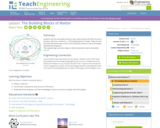
Students learn about atoms and their structure (protons, electrons, neutrons) — the building blocks of matter. They see how scientific discoveries about atoms and molecules influence new technologies developed by engineers.
- Subject:
- Chemistry
- Physical Science
- Science
- Material Type:
- Lesson
- Provider:
- TeachEngineering
- Provider Set:
- TeachEngineering
- Author:
- Brian Kay
- Daria Kotys-Schwartz
- Janet Yowell
- Malinda Schaefer Zarske
- Date Added:
- 02/17/2021
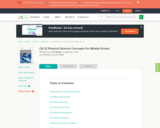
CK-12 Physical Science Concepts covers the study of physical science for middle school students. The 5 chapters provide an introduction to physical science, matter, states of matter, chemical interactions and bonds, chemical reactions, motion and forces, and the types and characteristics of energy.
- Subject:
- Chemistry
- Science
- Material Type:
- Textbook
- Provider:
- CK-12 Foundation
- Provider Set:
- CK-12 FlexBook
- Date Added:
- 11/01/2012
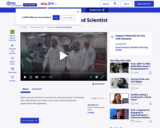
Meet a guy who started as a curious kid, overcame his fear of chemistry class, discovered a cool career, and is now a food scientist who experiments with vegetables.
- Subject:
- Career and Technical Education
- Material Type:
- Audio/Video
- Provider:
- PBS LearningMedia
- Provider Set:
- Career Connections
- Date Added:
- 12/01/2022

Working in teams of three, students perform quantitative observational experiments on the motion of LEGO MINDSTORMS(TM) NXT robotic vehicles powered by the stored potential energy of rubber bands. They experiment with different vehicle modifications (such as wheel type, payload, rubber band type and lubrication) and monitor the effects on vehicle performance. The main point of the activity, however, is for students to understand that through the manipulation of mechanics, a rubber band can be used in a rather non-traditional configuration to power a vehicle. In addition, this activity reinforces the idea that elastic energy can be stored as potential energy.
- Subject:
- Chemistry
- Engineering
- Science
- Material Type:
- Activity/Lab
- Provider:
- TeachEngineering
- Provider Set:
- TeachEngineering
- Author:
- Brian Kay
- Daria Kotys-Schwartz
- Janet Yowell
- Malinda Schaefer Zarske
- Date Added:
- 09/18/2014

A podcast tutorial describing the main characteristics of matter. [1:02]
- Subject:
- Science
- Material Type:
- Lesson
- Provider:
- Sophia Learning
- Date Added:
- 08/07/2023

Here you can find all kinds of helpful information about chemistry. Learn about reactions, elements, atoms, matter, or biochemistry. Downloads and activities are also included.
- Subject:
- Science
- Material Type:
- Unit of Study
- Provider:
- Chem4Kids
- Author:
- Andrew Rader Studios
- Date Added:
- 08/28/2023

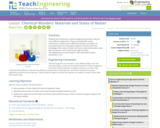
Students are introduced to chemical engineering and learn about its many different applications. They are provided with a basic introduction to matter and its different properties and states. An associated hands-on activity gives students a chance to test their knowledge of the states of matter and how to make observations using their five senses: touch, smell, sound, sight and taste.
- Subject:
- Chemistry
- Engineering
- Science
- Material Type:
- Activity/Lab
- Lesson Plan
- Provider:
- TeachEngineering
- Provider Set:
- TeachEngineering
- Author:
- Abigail Watrous
- Denali Lander
- Janet Yowell
- Katherine Beggs
- Date Added:
- 09/18/2014
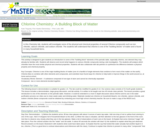
This activity provides a demonstration and lab exploration of one of the main "building blocks" of the periodic table of elements: chlorine. During the lab, students compare physical and chemical properties of chlorine compounds.
- Subject:
- Chemistry
- Science
- Material Type:
- Activity/Lab
- Simulation
- Provider:
- Science Education Resource Center (SERC) at Carleton College
- Provider Set:
- Pedagogy in Action
- Author:
- Kate Tinguely
- Date Added:
- 02/24/2021

This lesson will introduce the systematic classification of matter used in chemistry, defining the terms heterogeneous, homogeneous, pure substance, mixture, compound, element and providing examples.
- Subject:
- Science
- Material Type:
- Audio/Video
- Provider:
- Sophia Learning
- Date Added:
- 12/01/2023

Watch the ZOOM cast find out how many balloons filled with air and then with water are required to support the weight of a cast member.
- Subject:
- Chemistry
- Engineering
- Physics
- Science
- Material Type:
- Activity/Lab
- Provider:
- PBS LearningMedia
- Author:
- National Science Foundation
- WGBH Educational Foundation
- Date Added:
- 01/22/2004

In this video segment adapted from ZOOM, two solar cookers are tested against a control to see which can cook a "s'more" faster.
- Subject:
- Chemistry
- Engineering
- Physics
- Science
- Material Type:
- Activity/Lab
- Provider:
- PBS LearningMedia
- Author:
- National Science Foundation
- WGBH Educational Foundation
- Date Added:
- 02/20/2004

This video from NASA features the Cosmic Origin Spectrograph (COS), which allows scientists to use spectrographic analysis to assess the composition of intergalactic material.
- Subject:
- Chemistry
- Engineering
- Physics
- Science
- Material Type:
- Lesson
- Provider:
- PBS LearningMedia
- Author:
- NASA
- WGBH Educational Foundation
- WNET
- Date Added:
- 05/23/2012
